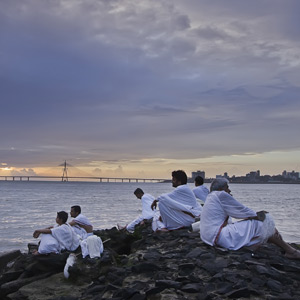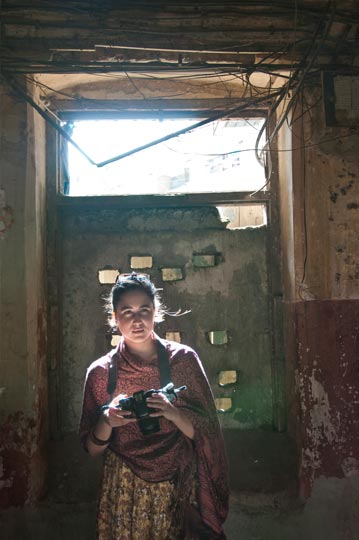The Intersection of Cinema, Art, and Existential Philosophy

If one were to chop this film into its composite stills, many of these still shots (as at left) could be celebrated art.
The National Film Award winner Ship of Theseus is a remarkable film, not the least because Anand Gandhi, the man behind it, offers a promising package of creativity, art, and inquiry—all on an alluring canvas.
The use of the word “canvas” to describe the visual element of a film is both somewhat clichéd and often errant. “Movies,” after all, are all about moving images, while “canvas” has been synonymous with paintings, a decidedly static medium, even when it comes alive through artistry.
It is only rarely, while watching a film like Ship of Theseus does it dawn on us that there is, after all, some relevance and even wisdom in using “canvas” to describe the visual element of a film. If one were to chop this film into its composite stills, many of these still shots would rival the most celebrated of our canvasses.
Indeed, this visual artistry, combined with equally exquisite and nuanced sounds, makes this film, first and foremost, a memorable sensory treat. One soon realizes that the other elements of the film such as casting, acting, and direction match up to the benchmark it establishes through its fine sheen.

What can be more oxymoronic than a blind photographer? But not so fast! The character of Aaliya Kamal (played by Aida Elkashef) is more than willing to defy such a generalization.
What is most energizing though is that the whole enterprise of cinematic art and entertainment is in service of a philosophical inquiry into our selves. This is done through the stories of three diverse characters who come holistically together to fulfill this ambitious undertaking: a blind photographer rebelling against and overcoming her handicap, a Jain monk caught between the friction of his aspirations of moksha and his human frailties, and a conscientious stockbroker.
The deftness of the film is not surprising considering Anand Gandhi, the film’s 33 year-old director, has been interested in theater since the tender age of seven. At 19, he was writing dialogue for Hindi soaps like Kyunki Saas Bhi Kabhi Bahu Thi. From dabbling in stories of quotidian quarrels to evolving to subjects of existential inquiry came natural to this filmmaker who says, “One singular aspiration in all my work is to attain the quality of awe. And what is awe? Awe is when you come across something that is infinitely complex and inexplicable in its origin.”
Not surprisingly, he crafted Ship of Theseus around the question raised by Plutarch, the Greek philosopher: If a ship were reconstructed entirely through parts borrowed from other ships, is it still the same ship? Those so inclined will see in Gandhi’s film questions like these: What makes us who we are? Are we the sum of our parts? Woven in are also themes touching up on identity, justice, beauty, meaning, and death.
At two and a half hours, the film does test the audience’s patience, even if only a bit. Some scenes—the monks trudging through a semi-rural landscape—seem gratuitous. The conversations between the characters, while mostly intelligent and thought-provoking, sound stilted in places, almost as if the storylines have been forcibly shoehorned into the lives of the characters to fit with the grand narrative of the original Greek thought experiment.
In summary though, throughout the film the director’s prowess is evident in the subtle alchemy of philosophy, realism, and humor brought together by brilliant visuals and a keen sense of time and place. The film has been duly rewarded with accolades at several film festivals, culminating in the top prize at India’s National Film Awards for 2013.
Khabar spoke to Anand Gandhi before a special film screening of the Ship of Theseus in Atlanta at the LeFont Theaters.

“One singular aspiration in all my work is to attain the quality of awe. And what is awe? Awe is when you come across something that is infinitely complex and inexplicable in its origin,” says Anand Gandhi, the man behind Ship of Theseus.
We’d like to hear about your background and interest
in filmmaking. Can you talk about your transition
from writing for soaps to Ship of Theseus?
I was writing for Kyunki when I was 19 years old.
So that was a while ago. And, it’s not been a linear
transition. Even then I was doing theater that was
more directly related to the content I am working on
now… I think there are two kinds of evolution that
happen in an artist. One is the evolution of the worldview
where you make yourself more and more informed
and you expose yourself to the greatest breakthroughs
in science, in evolutionary biology, in
neuroscience, in physics, and you keep yourself
informed with the greatest breakthroughs in thinking.
And you inherit the ancient wisdom. So, (as an artist)
you constantly work on the worldview. And the other
thing is the craft. You work on design, sense of colors,
composition, layout, on moods, on dramaturgy, on
structuring, technique, and all kinds of things that
have to do with craft and how you have put things in
order to create a certain meaning. You understand
the language. You understand that words when put
together in a certain permutation create a certain
meaning and a certain emotional response in people.
That’s one of the other evolutions that happen. So
when you use the skill set that you have acquired over
a period of time to articulate the worldview that has
evolved over a period of time, art emerges from that.
That’s the consequential evolution. It has been a long
journey. There have been many, many milestones, so it
will be impossible to distill down to a line.
Can you talk about one of those many
milestones?
Well, the first one for me would be the first play
that went out into the world. It’s a Hindi play called
Sugandhi. I was 19 years old when I wrote it. I had
written plays before that and they had been performed
in various spaces but this was really the first major
work. It had a great response around the country
and won several awards. It was very, very validating. I
think that was a first milestone, in terms of being able
to articulate a complex worldview into something
visceral and intuitive.

Navin (Sohum Shah) is out to prove, if to no one but himself, that beyond his deal-chasing stockbroker persona there is someone who places his ideals above money.
You’ve talked about certain aspects of what
made you who you are. Following that train of thought,
could you talk about your training in the
craft of filmmaking?
From the point when I started learning language, I
started writing. I began writing the moment I learned to
write. And I was very inspired by the fiction that I had
come across till then in my life. My mother had exposed
me to a lot of theater. So by the time I was seven
years old I was already a theater fan. I used to love going
to the theater to watch plays. And for some reason I
had the arrogance to think that I could write plays, even
though I was not equipped to do that. So I started writing
at a very early age. I wrote my first dialogue piece,
which I thought was a play—it was actually a skit—at
the age of seven. I started performing in small skits and
sketches that I would write for schools and community
events. And I would gauge the response that every line
and every movement would generate. Based on that response
I’d return to the same piece and modify it. Then
I learned another thing, something that has stayed
with me since the age of nine and has been my way of
writing till today. And that is to not keep going back and
changing the narrative again and again. Instead just
narrate the story and see the response. So I started doing
that. Before I would pick up the pen I would build a
whole narrative in my head and share it with people.
And each time based on the response I would get I
would put it back on the paper. And the story would
keep evolving over a period of time in my head—till it
was complete with nuances and quirks and small observations
and contradictions, and rich and holistic—
till I started sensing that it’s a wholesome piece of
work. And once I felt like I’d gathered enough material
I would start putting it on paper. That is my process.
Have you had any formal training in filmmaking?
I dropped out of my first year of undergraduate
education. And after that I chose my own education.
And I designed it in a very formal way. I stuck to it with
a lot of discipline. So by that measure it’s very formal.
You talked about how your mother got you into
reading fiction at an early age. Can you talk about
some of your early inspirations? Things you might go
back to often...in fiction, nonfiction, or movies?
The inspirations have steadily changed. But there
is no one thing that I go back to from an early period.
I have witnessed a very steady evolution of worldview
in craft and in things that engage me. And I feel
no nostalgia towards material that engaged me when
I was younger. So I don’t necessarily go back to most
of it. Of course there are some things that are timeless.
Like Dr. Seuss! But I don’t necessarily go back to
Dr. Seuss, right? I probably do it somewhere in my
subconscious, though. But there have been lots of
people that have inspired me steadily. And there are
some who have not dropped off the list.
Like?
Kabir is one poet who has not dropped off the list
ever. He has inspired me since childhood.

Maitreya (played by Neeraj Kabi), the Jain monk, represents mankind’s epic struggle between selflessness and self-preservation.
What do you expect audiences to get out of
this film?
One singular aspiration in all my work is to attain
the quality of awe. And what is awe? Awe is when you
come across something that is infinitely complex and
inexplicable in its origin—and yet comprehensible in a
singular gasp of experience. And for me it is an incredibly
important emotion, an incredibly important emotional
experience to engage with the cosmic void that
humanity has been in a constant dialogue with for
13,000 years. And for the longest time, the void hasn’t
answered back. In the last century, we have steadily
and exponentially found relevant answers from this
void, and that has fed into this feeling of wonder and
awe that we have. A century ago the narrative was that
if we probe too much into it we would lose out on our
potency of wonder but it’s exactly the reverse that has
happened. When we’ve looked into the molecule we
found the atom and when we looked into the atom we
found the electron and when we’ve looked at the
electron we have experienced sheer awe at its quantum
probabilistic nature. So each time the awe has expanded—
and for me a film has to grasp that, and translate
that experience. And that’s what I’m aspiring
that the audience (will take away).
Have there been films that have had the same
effect on you?
Yes, there have been many films. There’s Michael
Haneke’s White Ribbon. There’s Songs from the Second
Floor by Roy Andersson. There’s Andrei Tarkovsky’s Solaris,
of course. There’s (Stanley) Kubrick’s 2001: A Space
Odyssey. There’s (Krzysztof) Kieslowski‘s The Decalogue.
There are lots of films that have done that for me.
Could you comment on the state of the contemporary
Indian film industry? Where do you
see your role as a filmmaker fitting into the larger
film landscape?
See, I don’t know because …it’s a very specific kind
of reality that Indian filmmakers face. I mean, when
it comes to filmmakers, we are asked to comment on
the industry always. You know, writers aren’t expected
to comment on it. You wouldn’t expect (Michel)
Houellebecq to comment on [the state of] French
literature. (Laughs). It’s a very specific thing that I find
very curious. Who am I to comment on an industry
that I am not necessarily informed by—and I am not
an active participant of?
So you don’t see yourself as an active participant
in the Indian film landscape?
I mean, I see myself as an active filmmaker out
of India. I see myself as an active cinema enthusiast,
and cinema maker out of India who is informed by
the cinema of the world and contributes back to the
cinema of the world, not just India. So I find that
question a bit limiting.
Is the movie now available for free in India? If so,
why is that?
Yes, because we have benefited so much from the
open culture the last decade or so. My friends and I
could not have received our education were it not for
this open and free culture…and sometimes, the student
culture. So it would have been completely hypocritical
of us to adhere to dated copyright laws when we
ourselves have benefited from the open sharing of
knowledge and experience.
Can you comment on the documentary style that
you have employed in the movie even though it’s all
fiction?
Yes, it’s shot the way that you would usually expect
documentaries to be made. And the reason for that was
to perfect the illusion of reality. To make it look so real
that it’s almost confusing.
Girija Sankar is a Atlanta based freelancer whose work has appeared in Eclectica, JMWW, Alimentum, Youngzine, and Muse India.
Enjoyed reading Khabar magazine? Subscribe to Khabar and get a full digital copy of this Indian-American community magazine.
blog comments powered by Disqus










